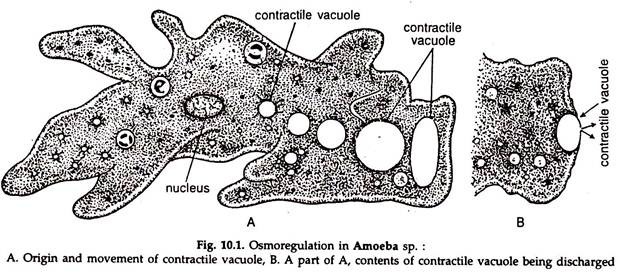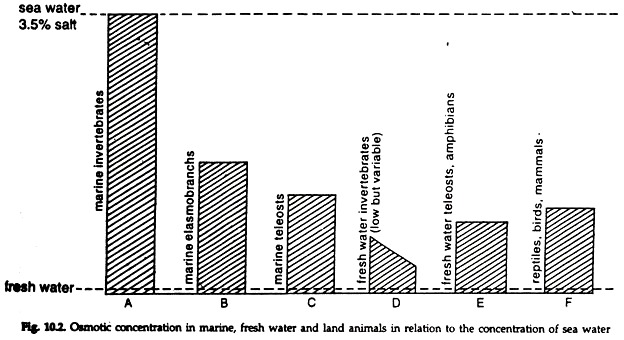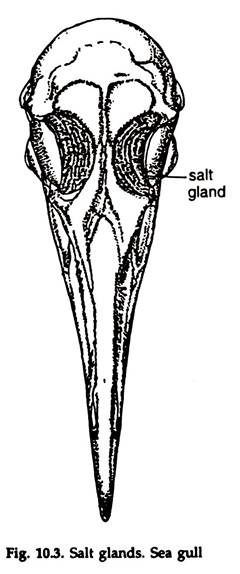In this article we will discuss about the mechanism of osmoregulation of body fluids in animals, explained with the help of suitable diagrams.
The mechanisms by which internal body fluids are maintained relatively constant, both in its volume and its contents, is known as osmoregulation. The interstitial fluid, the coelomic fluid, the water in blood are collectively named internal body fluid or extracellular fluid (e.c.p).
The chief constituents of extracellular fluid are ions, glucose, phosphatase, amino acids, etc. and they are in osmotic balance with the intracellular fluid. To maintain such an environment, there must be a regulatory mechanism to balance water loss against water gain and in and outflow of other materials.
Water is gained through osmosis following concentration gradient in aquatic animals through body surface, gills, from the water they drink, from the food they consume, and in land animals—through the water they drink, food taken, absorption of atmospheric moisture and in both groups from water yielding metabolic reactions.
ADVERTISEMENTS:
Water is lost in urine, through respiratory membranes, sweat glands, surface evaporation, etc.
Animals inhabit four different environments—fresh water, brackish water, sea water (marine) and land. The salinity of open sea water is about 35% (35 parts per thousand), that of brackish water far low and variable, as the rivers and streams discharge fresh water at the estuaries.
The degree of capability in maintaining a constant salt concentration in, the extracellular fluid and also the body volume, varies greatly in aquatic animals.
Accordingly they may be placed in the following categories:
ADVERTISEMENTS:
Osmoconformers:
The salt concentration in the body fluid changes with the salt concentration in the medium, the salt concentration of the body fluid conforms with that of the medium.
Oslnoregulators:
The salt concentration in the body fluid does not change with the salt concentration in the medium; the salt concentration of the body fluid remains near constant, irrespective of changes in the medium.
ADVERTISEMENTS:
Volume conformers:
The body volume changes with the change in salt concentration in the medium. In lower concentration in the medium, water enters the body and the volume increases, in higher concentration it decreases.
Volume regulators:
Animals capable of maintaining a constant body volume irrespective of salt concentration in the medium.
Ionic conformers:
Animals incapable of maintaining a constant ionic level in the body against changes in ionic concentration in the medium. Ionic concentration in the body fluid changes directly with the ionic concentration in the medium.
Ionic regulators:
Animals capable of maintaining a constant ionic level in the body against changes in ionic concentration in the medium. Capability of animals to survive in different aquatic environments also vary greatly.
Stenohaline (Gr. stenos = narrow + halinos = saline):
ADVERTISEMENTS:
Animals with a limited tolerance of changes in the salinity of the medium. A minimal concentration of salt is needed for survival and this phenomenon is present in osmoconformers. Stenohalines usually live in the open seas.
Euryhaline (Gr. eurys = wide):
Animals able to tolerate a wide range of salinity. These marine organisms can move into brackish or even fresh water and survive there.
Osmoregulatory organs and nitrogenous wastes:
The chief osmoregulatory organs in aquatic animals are gills and excretory organs. In land forms, the sites for water loss are excretory organs, respiratory membranes and skin. Animal living in water or having access to plenty of water, secrete major bulk of nitrogenous wastes in the form of ammonia, which is highly toxic and needs immediate removal (ammonotelic).
In a situation where water availability is somewhat limited, ammonia is largely converted into urea, which is highly soluble but less toxic (ureotelic). The urea is converted to uric acid, which is only sparingly soluble in water and almost nontoxic, in animals where reduction in volume of urine and thereby conservation of water is important (uricotelic).
Osmoregulation in invertebrates:
The salt concentration in the body fluid of invertebrates ranges from 0.1 to 0.4 per cent. In protozoon and some small animals water entering the body by diffusion is expelled to the exterior through contractile vacuole (Fig. 10.1) or some other means. Cnidaria and ctenophores are osmotic conformers.
Very little is known about the osmoregulation in marine invertebrates, though a host of them live in brackish water and in open sea. Experiments on Neanthes, Aretticola, Maia, Carcinus and others show that osmoregulation in these animals is restricted within a very narrow range.
Excretory organs, the chief osmoregulatory structures, exhibit a wide diversity in invertebrates, but basically, they are similar. The organ consists of a tubule or a sac, capable of concentrating wastes. One end of the organ usually opens in the coelom and the other end opens outside.
Excretory molecules filtered into the coelomic fluid from the haemolymph or blood, move into the tubule through the opening, the nephrostome by ciliary action, while in the tubule, glucose, amino acids, salts, minerals and even water in some cases, are reabsorbed.
The cells of the tubules also secrete wastes and the fluid in the tubule, rich in wastes, the urine passes to the exterior through an opening, the nephridiopore (nereis). Such an excretory tubule has been named nephridium.
In the absence of a nephrostome the blood filtrate is directly received by the tubule and due to secretion of wastes and selective reabsorption, the urine is formed (leech). The nephridiopore may be absent (earthworm) and the nephridium open directly to the gut singly or many of them joining to form a common passage before opening in the gut.
Nephridia are segmentally arranged in annelids. In platyhelminthes, rotifers and some others the nephridium assumes a different shape, the flame cell, opening to the exterior. A molluscan kidney is really a nephridium. Since the number is one or two, the size has greatly enlarged.
It is spongy in nature, enclosing a space within, one end opening into the pericardial chamber through a Reno pericardial aperture and the other end in the mantle cavity through a renal aperture. In molluscs, other than pulmonates, living in water throughout the year, the nitrogenous wastes excreted are chiefly in the form of ammonia.
The salt concentration in the body fluid of fresh water mussels and gastropods is as low as 0.1 to 0.2 per cent. Salt level is maintained by selective reabsorption of salts in the kidneys and producing a very hypo-osmotic urine and also by active absorption of salts through the mantle and body surface.
The amphibian gastropod molluscs and pulmonates produce uric acid to conserve water during the long period of aestivation; no urine is formed and the uric acid is stored in the digestive gland, to be released slowly after regaining activity in the next monsoon.
To prevent water loss, the aestivating non-operculate snails secrete a calcic epiphragm closing the mouth of the shell, leaving only a small opening for movement of air for respiration. The land snails can withstand a water loss equivalent to the 50 per cent of their body weight, the slugs can withstand 80 per cent water loss.
The paired, saccular excretory glands, the green glands are present in crustacea. They are located in the cephalothorax and richly supplied with blood. Filtrate is subjected to selective reabsorption in the glandular portion, stored temporarily in the sac and a hypotonic urine is passed to the exterior through the renal pores at the base of the antenna. The gills have the ability to collect salts.
The excretory organs of insects and arachnids are narrow threadlike Malpighian tubules at the junction of intestine and rectum. The number of tubules vary from two in trochophore larva, Scolopendra to four in scorpion and many in cockroach.
Wastes are absorbed from the haemolymph, concentrated in the tubules and discharged in the gut. Water is absorbed in the rectum and the urine is passed out in the form of a paste. In terrestrial arthropods the excretory organs are modified to secrete hyperosmotic urine and thereby minimise water loss.
Osmoregulation in vertebrates:
The salinity of vertebrate body fluids ranges from 0.5 to 0.9 per cent. As a rule, the vertebrates are osmoregulators and the hazards of maintaining a constant osmotic concentration in the body fluid are somewhat pronounced.
The fresh water forms have adaptations to prevent inflow of water, outflow of salts and also to collect salts from the medium. A certain amount of salt and water are received through food. Against this, the animals living in brackish water and in open seas must have a different kind of adaptation.
The salinity of even brackish water is much higher than the salinity of the body fluid, the salinity shooting up to about 400 per cent greater in open seas. In these forms, mechanisms have developed to prevent outflow of body fluid water and inflow of salts and also to excrete salts, which enter the body through food and the water.
In land forms the problem chiefly centres about conservation of water. Water enters the body only through extraneous sources like food, including plant sap and animal body fluid and the water they drink.
On the other hand, they lose water in different ways, namely excretion, expiration, perspiration, etc. Of the various adaptations for conservation of water, formation of insoluble nitrogenous wastes and hypo-osmotic urine are most important.
Osmoregulation in fresh water vertebrates:
Fresh water vertebrates live in a very hypo- osmotic medium. To maintain an equilibrium with the body fluid, water tends to move in through body surface and gills and salts tend to go out in excretion.
These are overcome by maintaining a minimum salt concentration in the body fluid to permit metabolism; reabsorption of salts in the excretory organs and formation of hypo-osmotic urine and expulsion of nitrogenous wastes in the form of ammonia.
Selective absorption of salts by active transport through gills and skin is present. The fresh water teleost’s absorb Na+ by active transport through gills. Frogs take up Na+ and CI– through skin, water and salts are reabsorbed from the urinary bladder and urine discharge is usually stopped in dry season.
The skin being impermeable, fresh water reptiles receive water through diet. To overcome deficit of water, the filtration rate is low in the kidneys, urine is very concentrated and may be even solid. Nitrogenous wastes are converted into uric acid.
Osmoregulation in marine vertebrates:
Marine vertebrates live in a very hyperosmotic environment, the salinity in open sea being about four times higher than that in their body fluids. To maintain an equilibrium with the surrounding medium, body water tends to move out and salts tend to move in through structures like gills and body surface. Water conservation in marine vertebrates is hazardous and as they cannot use sea water freely, the sea has been described as a physiological desert to its inhabitants.
The adaptations that helped marine teleost’s to live successfully in sea are:
(a) An impermeable body surface and a mucous covering preventing in and outflow of materials.
(b) Capability to drink sea water and make use of water and monovalent ions in it and passing out the divalent ions from the gut.
(c) Urine volume is minimal and only some nitrogenous wastes are removed through it (Fig. 10.2).
(d) Ammonia, constituting the main bulk of the nitrogenous wastes is eliminated through gills.
(e) Removal of excess Na+ and CI ions through gills.
Presence of a large amount of urea and trim-ethyl amine oxide in blood and tissues make the elasmobranchs iso-osmotic in sea water. Like other fishes, elasmobranch gills are not permeable to urea. The accumulated salts through food and inward diffusion across the gills are excreted through kidneys and a rectal gland in communication with the rectum.
Marine reptiles and birds exhibit similar osmoregulatory mechanism. Their internal osmotic pressure is less than that of their environment. Salt intake occurs through food. The water is reabsorbed from the kidneys and the nitrogenous wastes are converted to uric acid.
In turtles, the excess salt is secreted through orbital glands, the modified lacrimal glands; through nasal glands in marine iguana and through salt glands (Fig. 10.3) in marine birds.
The marine mammals eat both invertebrates and vertebrates living in sea. The invertebrates are iso-osmotic with sea water and the fishes are hypo-osmotic with sea water. Marine mammals maintain their body salt concentration by secreting a urine having greater salt concentration than sea water.
Osmoregulation in land vertebrates:
Of the different modes of water losses in terrestrial vertebrates, viz. urine, faeces and evaporation, the last one accounts for maximum loss. The air is capable of holding a certain amount of water vapour. This is constant for a volume of air at a given temperature and pressure. Saturation deficit is the amount of water vapour required to saturate the air in addition to the water vapour already present in it.
The saturation deficit is the amount of water to be evaporated from the organisms to the environment. This again is regulated by different biotic and abiotic factors in the area. The principal sites of evaporation in land animals are the body surface and the respiratory surface. Water lost is made up by drinking water, through food and absorption of moisture through body surface.
Frogs and toads are greatest victims of water loss by evaporation. The loss is minimised by venturing out only in nights and excreting urea, which is less toxic but highly soluble in water. Certain amount of water is obtained from food.
More resistant skin to water loss and excretion of nitrogenous wastes in the form of uric acid play important role in water conservation in reptiles. In birds, water loss from body surface is prevented by feathers. Urine is hyperosmotic and nitrogenous wastes are eliminated in the form of uric acid.
Of all the groups of animals, the mammals are best adapted to their environments. With one exception (desert) they live close to sources of water. The skin is resistant to water loss, hairs have developed to insulate the body from outside; urine produced is hyperosmotic, the uric acid concentration is as high as 6 per cent. In addition, they procure a good amount of water with food.
Extreme modifications are found in desert animals. The Kangaroo rats (Dipodomys) of South Western North American desert, practically with no access to water, live on dry seeds. But their bodies contain about 66 per cent water, as in other mammals. The water loss does not exceed the gain, even if they live on dry food alone.
Most of their water requirement comes from the water produced in oxidation of the dry food and from a small percentage of water present in the grains. Further, they lack sweat glands, as they do not need water for temperature regulation, because of their natural habits help them to avoid the heat of the day.
Their faeces is almost dry and they produce highly concentrated urine containing as much as 23 per cent urea and 7 per cent salt.
Camels, the ship of the desert, can survive great water loss. They can drink water as much as 150 litres, one-third of their total body weight, within 10 minutes. The water loss is gradual and the animal can survive for at least 17 days after a drink. Sweat glands are present but sweating begins only at 41°C. The desert nights are cool.
The body temperature of camel drops as low as 34°C at dawn and much of the day elapses before the temperature rises to 41°C, at which sweating begins. The remarkable fluctuation of 7°C in contrast to only about 1.1°C in man, helps to minimise loss of water through sweating.
The significant adaptation in camels is that the microorganisms in the gut convert urea back to protein and thereby save water loss from the kidneys to excrete urea.


